2016 Peugeot Expert VU checking oil
[x] Cancel search: checking oilPage 12 of 520
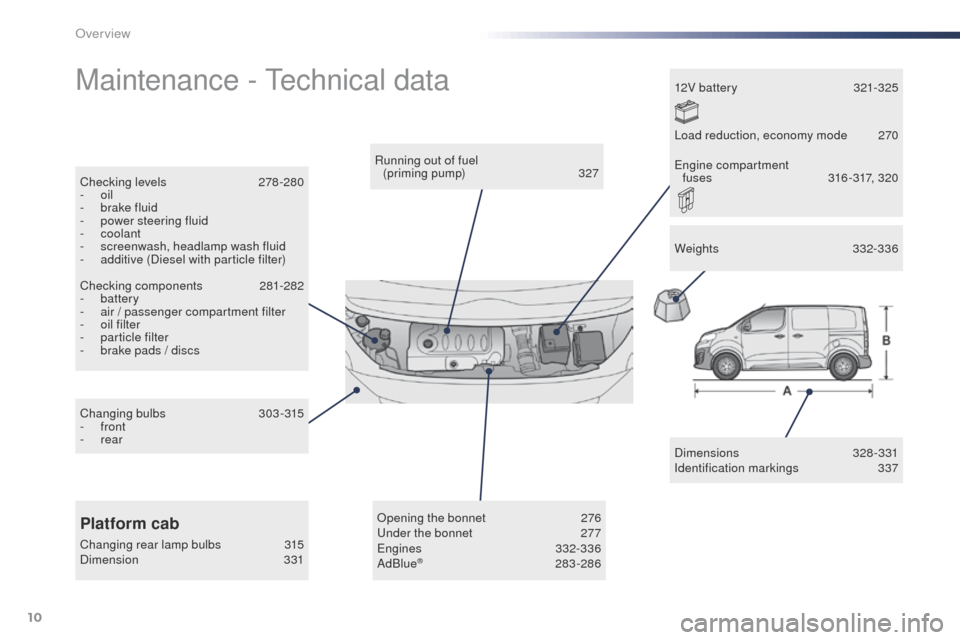
10
Maintenance - technical data
Dimensions 328-331
Identification markings 3 37
Running out of fuel
(priming pump)
3
27
Checking levels
2
78 -280
-
oil
-
b
rake fluid
-
p
ower steering fluid
-
coolant
-
s
creenwash, headlamp wash fluid
-
a
dditive (Diesel with particle filter)
Checking components
2
81-282
-
battery
-
a
ir / passenger compartment filter
-
o
il filter
-
p
article filter
-
b
rake pads / discs
Changing bulbs
3
03-315
-
front
-
rear
Platform cab
Changing rear lamp bulbs 3
15
Dimension 3 31 12V battery
32
1-325
op
ening the bonnet
2
76un
der the bonnet 2 77en
gines 332-336
AdBlue® 283-286 W eights
332-336
Load reduction, economy mode
2
70
en
gine compartment
fuses
3
16 - 317, 320
over view
Page 33 of 520
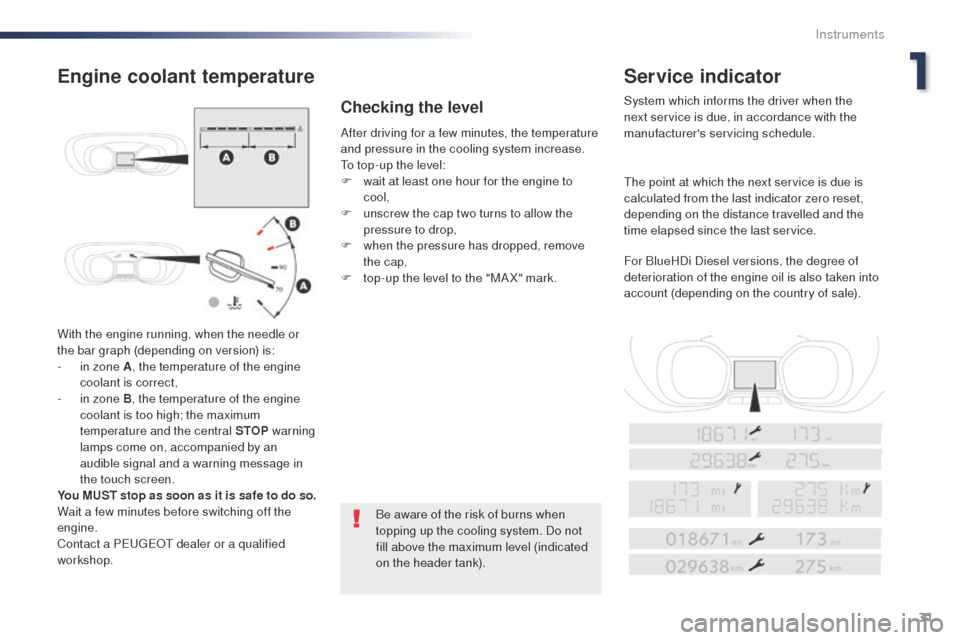
31
With the engine running, when the needle or
the bar graph (depending on version) is:
-
i
n zone A , the temperature of the engine
coolant is correct,
-
i
n zone B, the temperature of the engine
coolant is too high; the maximum
temperature and the central STOP warning
lamps come on, accompanied by an
audible signal and a warning message in
the touch screen.
You MUST stop as soon as it is safe to do so.
Wait a few minutes before switching off the
engine.
Contact a P
e
ugeot dealer or a qualified
workshop. After driving for a few minutes, the temperature
and pressure in the cooling system increase.
to t
op-up the level:
F
w
ait at least one hour for the engine to
cool,
F
u
nscrew the cap two turns to allow the
pressure to drop,
F
w
hen the pressure has dropped, remove
the cap,
F
t
op-up the level to the "MA X" mark.
Be aware of the risk of burns when
topping up the cooling system. Do not
fill above the maximum level (indicated
on the header tank).
Engine coolant temperature Service indicator
System which informs the driver when the
next service is due, in accordance with the
manufacturer's servicing schedule.
th
e point at which the next service is due is
calculated from the last indicator zero reset,
depending on the distance travelled and the
time elapsed since the last service.
For BlueHDi Diesel versions, the degree of
deterioration of the engine oil is also taken into
account (depending on the country of sale).Checking the level
1
Instruments
Page 280 of 520

278
Checking levels
take care when working under the bonnet, as certain areas of the engine may be extremely hot (risk of burns) and the cooling fan could start at
any time (even with the ignition off).
Engine oil level
the check is carried out either when
the ignition is switched on using the
oil level indicator in the instrument
panel for vehicles so equipped, or
using the dipstick.Checking using the dipstick
the location of the dipstick is shown in the
corresponding underbonnet layout view.
F t
a
ke the dipstick by its coloured grip and
remove it completely.
F
W
ipe the end of the dipstick using a clean
non-fluffy cloth.
F
R
efit the dipstick and push fully down, then
pull it out again to make the visual check:
the correct level is between the marks A
and B .
Check all of these levels regularly, in line with the manufacturer's service schedule.
t
o
p them up if necessary, unless other wise indicated.
If a level drops significantly, have the corresponding system checked by a P
e
ugeot dealer or a qualified workshop.
A = MA X
to e
nsure that the reading is correct, your
vehicle must be parked on a level sur face
with the engine having been off for more than
30
minutes.
It is normal to top-up the oil level between
two services (or oil changes). P
e
ugeot
recommends that you check the level, and top-
up if necessary, every 3 000 miles (5 000 kms). B = MIN
If you find that the level is above the A mark or
below the B mark, do not star t the engine .
-
I
f the level is above the MAX mark (risk
of damage to the engine), contact a
P
e
ugeot dealer or a qualified workshop.
-
I
f the level is below the MIN mark, you
must top-up the engine oil.
Practical information
Page 281 of 520
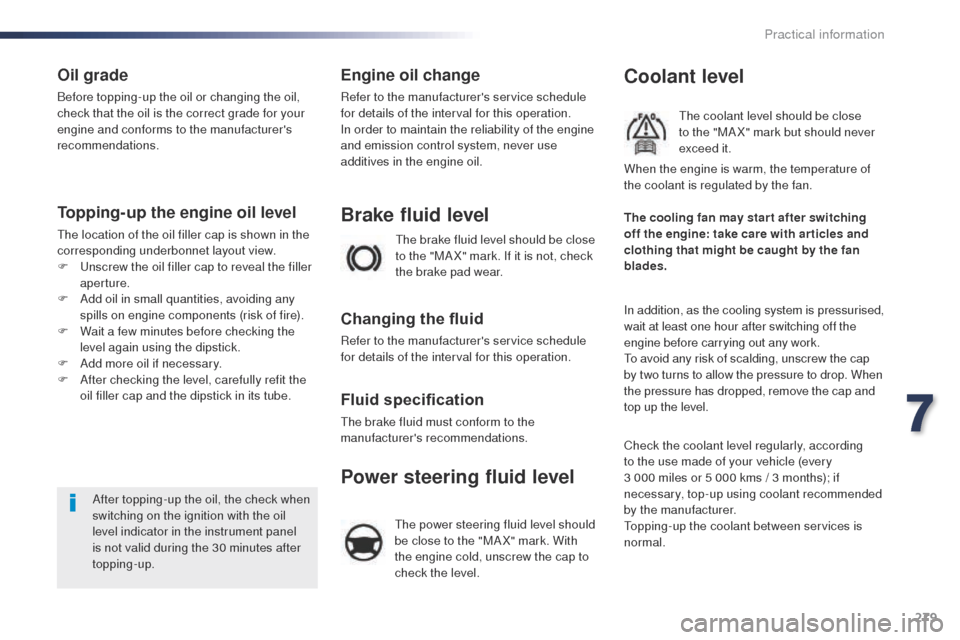
279
Oil grade
Before topping-up the oil or changing the oil,
check that the oil is the correct grade for your
engine and conforms to the manufacturer's
recommendations.
Topping-up the engine oil level
the location of the oil filler cap is shown in the
corresponding underbonnet layout view.
F u
n
screw the oil filler cap to reveal the filler
aperture.
F
A
dd oil in small quantities, avoiding any
spills on engine components (risk of fire).
F
W
ait a few minutes before checking the
level again using the dipstick.
F
A
dd more oil if necessary.
F
A
fter checking the level, carefully refit the
oil filler cap and the dipstick in its tube.
After topping-up the oil, the check when
switching on the ignition with the oil
level indicator in the instrument panel
is not valid during the 30 minutes after
topping-up.
Engine oil change
Refer to the manufacturer's service schedule
for details of the interval for this operation.
In order to maintain the reliability of the engine
and emission control system, never use
additives in the engine oil.
th
e brake fluid level should be close
to the "MA X" mark. If it is not, check
the brake pad wear.
Brake fluid level
Changing the fluid
Refer to the manufacturer's service schedule
for details of the interval for this operation.
Fluid specification
the brake fluid must conform to the
manufacturer's recommendations.
Coolant level
the coolant level should be close
to the "MA X" mark but should never
exceed it.
In addition, as the cooling system is pressurised,
wait at least one hour after switching off the
engine before carrying out any work.
to a
void any risk of scalding, unscrew the cap
by two turns to allow the pressure to drop. When
the pressure has dropped, remove the cap and
top up the level. The cooling fan may star t after switching
off the engine: take care with ar ticles and
clothing that might be caught by the fan
blades. When the engine is warm, the temperature of
the coolant is regulated by the fan.
Check the coolant level regularly, according
to the use made of your vehicle (every
3 000
miles or 5 000 kms / 3 months); if
necessary, top-up using coolant recommended
by the manufacturer.
to
pping-up the coolant between services is
normal.
Power steering fluid level
the power steering fluid level should
be close to the "MA X" mark. With
the engine cold, unscrew the cap to
check the level.
7
Practical information
Page 283 of 520
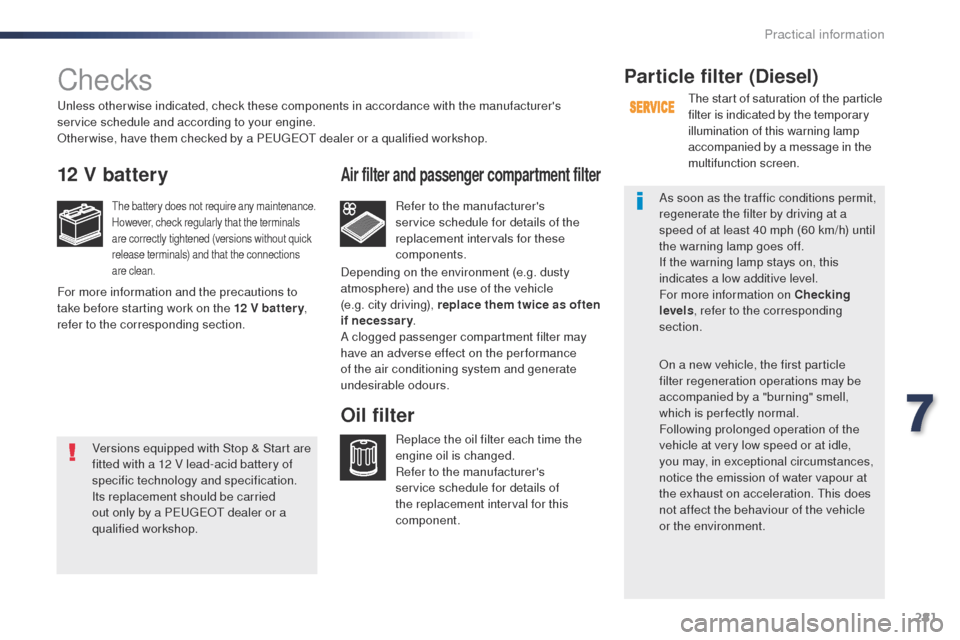
281
Checks
12 V battery
the battery does not require any maintenance.
However, check regularly that the terminals
are correctly tightened (versions without quick
release terminals) and that the connections
are clean.Refer to the manufacturer's
service schedule for details of the
replacement intervals for these
components.
Air filter and passenger compartment filter
Replace the oil filter each time the
engine oil is changed.
Refer to the manufacturer's
service schedule for details of
the replacement interval for this
component.
Oil filterParticle filter (Diesel)
the start of saturation of the particle
filter is indicated by the temporary
illumination of this warning lamp
accompanied by a message in the
multifunction screen.
As soon as the traffic conditions permit,
regenerate the filter by driving at a
speed of at least 40 mph (60 km/h) until
the warning lamp goes off.
If the warning lamp stays on, this
indicates a low additive level.
For more information on Checking
levels , refer to the corresponding
section.
on a n
ew vehicle, the first particle
filter regeneration operations may be
accompanied by a "burning" smell,
which is per fectly normal.
Following prolonged operation of the
vehicle at very low speed or at idle,
you may, in exceptional circumstances,
notice the emission of water vapour at
the exhaust on acceleration.
t
h
is does
not affect the behaviour of the vehicle
or the environment.un
less otherwise indicated, check these components in accordance with the manufacturer's
service schedule and according to your engine.
ot
her wise, have them checked by a P
e
ugeot
dealer or a qualified workshop.
For more information and the precautions to
take before starting work on the 12 V batter y ,
refer to the corresponding section. Depending on the environment (e.g. dusty
atmosphere) and the use of the vehicle
(e.g.
city driving), replace them twice as often
if necessary .
A clogged passenger compartment filter may
have an adverse effect on the per formance
of the air conditioning system and generate
undesirable odours.
Versions equipped with Stop & Start are
fitted with a 12 V lead-acid battery of
specific technology and specification.
Its replacement should be carried
out only by a P
e
ugeot
dealer or a
qualified workshop.
7
Practical information
Page 284 of 520

282
Manual gearbox
the gearbox does not require any
maintenance (no oil change).
Refer to the manufacturer's service
schedule for the checking interval for
this component.Brake wear depends on the style
of driving, particularly in the case
of vehicles used in town, over short
distances. It may be necessary to
Brake pads
For information on checking brake
disc wear, contact a Peugeot
dealer or a qualified workshop.
Brake disc wear
only use products recommended by
Pe ugeot or products of equivalent
quality and specification.
In order to optimise the operation of
units as important as those in the
braking system, P
e
ugeot selects and
offers very specific products.
After washing the vehicle, dampness,
or in wintry conditions, ice can form
on the brake discs and pads: braking
efficiency may be reduced. Make light
brake applications to dry and defrost
the brakes.
Parking brake
If excessive travel or a loss of
effectiveness of this system is
noticed, the parking brake must be
checked, even between two services.
Checking this system must be done by a
P
e
ugeot dealer or a qualified workshop.
have the condition of the brakes checked, even
between vehicle services.
un
less there is a leak in the circuit, a drop in
the brake fluid level indicates that the brake
pads are worn.
Automatic gearbox
the gearbox does not require any
maintenance (no oil change).
Refer to the manufacturer's service
schedule for the checking interval for
this component.
Electronic gearbox
the gearbox does not require any
maintenance (no oil change).
Refer to the manufacturer's service
schedule for the checking interval for
this component.
Practical information
Page 297 of 520
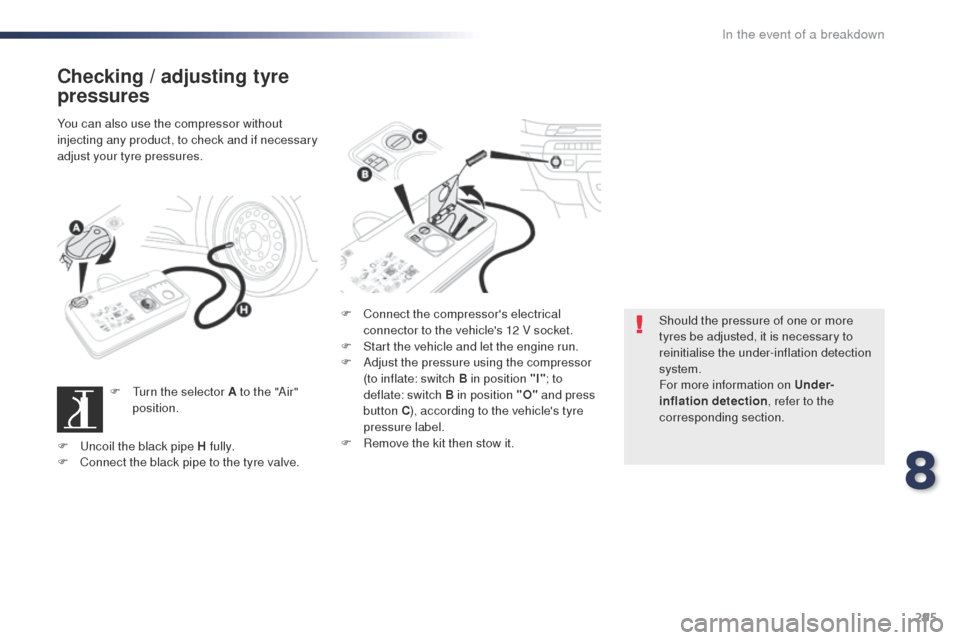
295
Checking / adjusting tyre
pressures
You can also use the compressor without
injecting any product, to check and if necessary
adjust your tyre pressures.F
t
u
rn the selector A to the "Air"
position. F
C
onnect the compressor's electrical
connector to the vehicle's 12 V socket.
F
S
tart the vehicle and let the engine run.
F
A
djust the pressure using the compressor
(to inflate: switch B in position "I" ; to
deflate: switch B in position "O" and press
button C ), according to the vehicle's tyre
pressure label.
F
R
emove the kit then stow it.Should the pressure of one or more
tyres be adjusted, it is necessary to
reinitialise the under-inflation detection
system.
For more information on Under-
inflation detection
, refer to the
corresponding section.
F
u
n
coil the black pipe H fully.
F
C
onnect the black pipe to the tyre valve.
8
In the event of a breakdown
Page 508 of 520
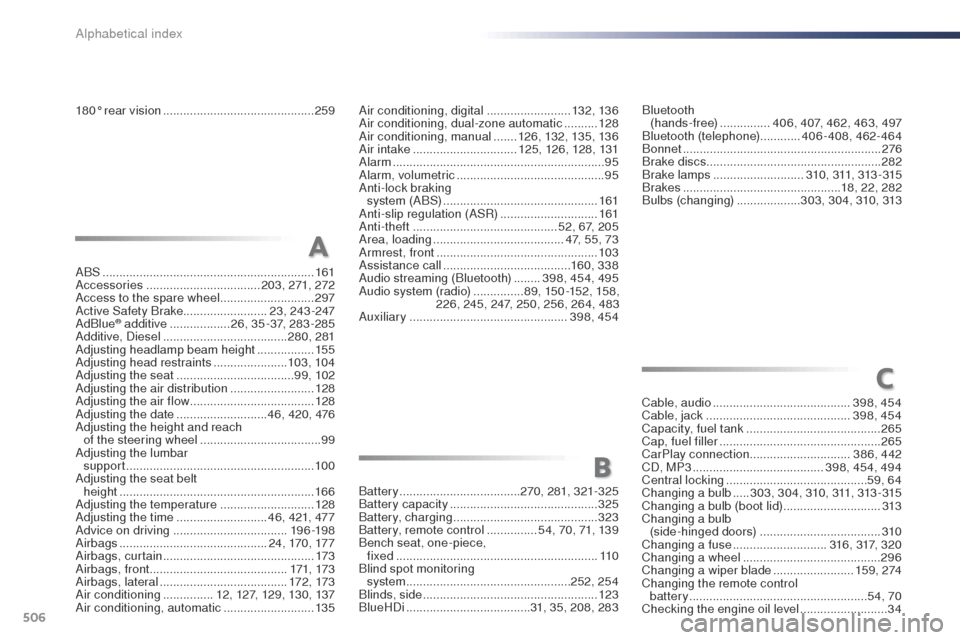
506
180° rear vision .............................................25 9
ABS
........
....................................................... 161
Accessories
.................................. 203, 271, 272
Access to the spare wheel
............................297
Active Safety Brake......................... 23, 243-247
AdBlue
® additive .................. 26, 35 -37, 283 -285
Additive, Diesel ..................................... 280, 281
Adjusting headlamp beam height
................. 15
5
Adjusting head restraints
......................103, 104
Adjusting the seat
................................... 99, 102
Adjusting the air distribution
.........................128
Adjusting the air flow
..................................... 128
Adjusting the date
........................... 46, 420, 476
Adjusting the height and reach of the steering wheel
.................................... 99
Adjusting the lumbar support
........................................................ 10 0
Adjusting the seat belt height
...............
........................................... 166
Adjusting the temperature
............................ 12
8
Adjusting the time
........................... 46, 421, 477
Advice on driving
.................................. 19 6 -198
Airbags
............................................ 24, 170, 17 7
Airbags, curtain
............................................. 17
3
Airbags, front ......................................... 171, 173
Airbags, lateral
...................................... 172 , 173
Air conditioning
............... 12, 127, 129, 130, 137
Air conditioning, automatic
...........................13 5Air conditioning, digital
.........................
132, 13 6
Air conditioning, dual-zone automatic
..........
128
Air conditioning, manual
.......
126, 132, 13 5, 13 6
Air intake
...............................
125, 126, 128, 131
Alarm
...............................................................
95
Alarm, volumetric
............................................
95
Anti-lock braking system (ABS)
..............................................
16
1
Anti-slip regulation (ASR)
.............................
161
Anti-theft
...........................................
52, 67, 205
Area, loading
...............................
........
47, 55, 73
Armrest, front ................................................
103
Assistance call
......................................
160, 338
Audio streaming (Bluetooth)
........ 3
98, 454, 495
Audio system (radio) ...............
89, 150 -152, 15 8,
226, 245, 247, 250, 256, 264, 483
Auxiliary ...............................................
398, 454
A
B
C
Battery .................................... 270, 281, 321-325
Battery capacity ............................... .............325
Battery, charging
........................................... 323
Battery, remote control
............... 5
4, 70, 71, 139
Bench seat, one-piece, fixed
............................................................ 11 0
Blind spot monitoring system
................................................. 252, 254
Blinds, side
.................................................... 123
BlueHDi
..................................... 31, 35, 208, 283Bluetooth
(hands-free)
............... 4
06, 407, 462, 463, 497
Bluetooth (telephone)
............
406-408, 462-464
Bonnet
...........................................................
276
Brake discs
.................................................... 28
2
Brake lamps
........................... 3
10, 311, 313 - 315
Brakes
...............................................
18, 22, 282
Bulbs (changing)
................... 3
03, 304, 310, 313
Cable, audio
.........................................
398, 454
Cable, jack
...........................................
398, 454
Capacity, fuel tank
..............................
..........
265
Cap, fuel filler ................................................
265
CarPlay connection ..............................386, 442
CD, MP3
....................................... 3
98, 454, 494
Central locking ..........................................
59, 64
Changing a bulb .....3 03, 3 0 4, 310, 311, 313 - 315
Changing a bulb (boot lid)
.............................313
Changing a bulb (side-hinged doors)
.................................... 3
10
Changing a fuse
............................316, 317, 320
Changing a wheel
.........................................296
Changing a wiper blade
........................15 9 , 2 74
Changing the remote control battery
..................................................... 5
4, 70
Checking the engine oil level
..........................34
Alphabetical index